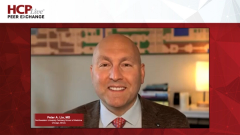
Pediatric Atopic Dermatitis: Considerations and Challenges With Oral Therapies
Peter A. Lio, MD, describes the challenges pediatric patients face with oral therapies for atopic dermatitis, focusing on ease of administration and patient adherence.
Episodes in this series

Raj Chovatiya, MD, PhD: I’ll toss it over to Peter and think about our more classic oral agents, methotrexate, cyclosporine. Maybe you can, for those who aren’t super familiar, tell us how long these have been around as an important mainstay for therapy. What are some of the challenges patients have in terms of adherence, and ease of use, and burden with these therapies?
Peter A. Lio, MD: I feel like once we have maximized and optimized our topical therapy, and my area of focus is trying all these crazy alternative and integrative approaches as well, but once we feel that we have done as best we can with that and we’ve maximized that, then I think we have to start bringing up the potential for going to a systemic agent. We know historically we’ve had, all off-label by the way, none of these we’re about to talk about are FDA approved. Well, let me say 1 is FDA approved that’s been grandfathered in, and that’s prednisone. Systemic corticosteroids technically are approved for the treatment of corticosteroid response to dermatoses, of which this would fall in place. But of course, we often try to push against using those because not only do they have a whole host of potential adverse effects, but for some patients, they can cause a pretty terrible rebound flare-up. I inherited, and I’m sure all 3 of us have inherited, lots of tough patients who have kind of become corticosteroid addicted or are really used to it, and that is a bad plan for most patients.
Now, do we meet people who sometimes use them and say I’ve never had trouble? Yes, but we’ve also met people potentially who say they’ve played Russian roulette for years and never died, but I wouldn’t recommend it. I don’t think it’s a wise game to play. I try to avoid it. Are there times when we need to use systemic corticosteroids? Yes, I would argue there are certain scenarios to use them as a rescue. If somebody’s going to Europe, somebody’s getting married, you just kind of have to do it. But in general we try to avoid it. So let’s take that off the table for a minute.
Then we have our conventional immunosuppressants. Methotrexate, cyclosporine, mycophenolate, azathioprine, those are the big 4. Most dermatologists in the United States, in particular pediatric dermatologists who use them more than adult dermatologists in this context, they’ve picked cyclosporine. I think cyclosporine really is the drug of choice. If you look, there’s this wonderful figure I was able to put together. Somebody helped me do it, but we put it together looking at the discontinuation rate of the conventional immunosuppressant agents, and it turns out that the best bang for your buck is cyclosporine. It still isn’t pretty. Many people have to discontinue due to potential adverse effects, and relatively few people get good control on that medicine long term, but compared to methotrexate it’s unbelievable.
Methotrexate is quite terrible. Approximately 6% of people get control on methotrexate, and mycophenolate was approximately 11%. These are very low numbers. I feel like it’s the wrong tool for the job for most patients. It’s kind of like using a brick to hammer in a nail, it can work, but there are all sorts of issues. Of course, with all of these agents, we have a whole host of potential adverse effects, lots of monitoring we have to do, and they’re all off-label. It’s very challenging to use them, and we’ve done it, but I think cyclosporine has been my favorite. Britt, for you too, I know you have mostly pediatric patients, do you use cyclosporine as your first line before some of the newer agents came out?
Brittany G. Craiglow, MD: Before they came out, yes for sure. Now, I joke that the residents aren’t going to know how to use this for atopic dermatitis anymore. I think especially if you want to try to cool someone down quickly, that was always our go-to for a severe patient who failed topicals, and/or phototherapy, or where phototherapy wasn’t a reasonable option. I used a lot of it. But again, you can’t use it forever, there’s a big conversation about risk, you’re subjecting a child to blood draws. It is something that you have to worry about the patient adhering to it. You can’t give someone a prescription for 3 months and just let them go. It’s very labor-intensive on the part of both the family and the clinician because of the monitoring.
Raj Chovatiya, MD, PhD: This thought about the labor associated with thinking about the treatment, then talking about the treatment, then monitoring for the treatment, and then thinking about when to stop it, that’s the big thing. It is a labor that’s on us, and it’s a labor on the patient and caregiver. If anything could highlight why we needed a bit of a revolution in treatment, I think that was it. And the fact that, bottom line, it works for some people but not everybody. You’re not getting people to the point of saying, “OK I’m almost completely clear and can get my life back.”
Transcript edited for clarity
Newsletter
Access practical, evidence-based guidance to support better care for our youngest patients. Join our email list for the latest clinical updates.







